Sony TVs in 2014: Everything you need to know
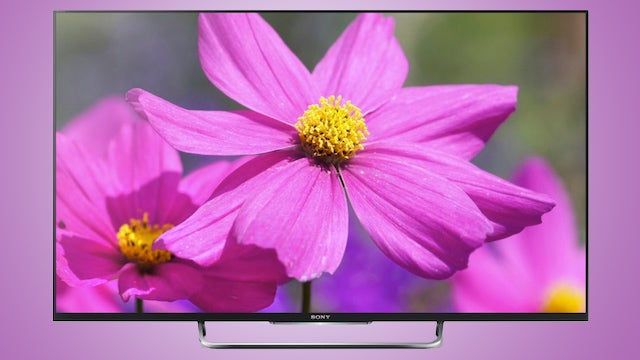
Sony TVs had a mixed 2013. There were some big highs, most notably being first to market with a ‘mainstream’ 4K TV, the outstanding Sony 65X9005A. This set went on to win numerous industry awards. But its key W8 TV series was a big disappointment, and we couldn’t shake the feeling that the brand didn’t have enough models in its range to fully engage with its main rivals.
First impressions from the show floor at the CES, though, suggest that Sony may be addressing some if not all of these issues for 2014. For starters its TV offering is larger, with new series being added at the top and centre of the range – and of course, 4K, a technology Sony wants to make its own, figures large.
There also appears to be a concerted effort to put picture quality first across the whole range, rather than focussing on just a couple of key models. Curves and OLED, on the other hand, are conspicuously absent…
Sony TV 2014 Reviews
Update 26/02/2014: We’ve now reviewed the first 2014 Sony TV and it’s got off to a near perfect start.
“The
Sony 50W829 is a blisteringly brilliant TV that deserves to sell by the
bucketload, and sets a mighty high bar for the rest of this year’s
incoming TVs to have to aim for. Plus, of course, the quality on show
here has got us drooling at the prospect of what Sony might be able to
deliver with its incoming higher-end models.”
Read our full Sony KDL-50W829 review
We’ve also taken a closer look at the smart TV system for 2014:
“Sony has rectified the worst issues with its 2013 smart TVs and produced a very good system that will please most buyers. There’s still room for improvement, however, particularly with its support of catch-up services, personalisation and second screen features. None are quite deal breakers for us, but they might be for you.”
Read our full Sony Smart TV 2014 review
SEE ALSO:
- Samsung TVs in 2014: Everything you need to know
- Panasonic TVs in 2014: Everything you need to know
- LG TVs in 2014: Everything you need to know
5 Things You Need to Know about Sony TVs in 2014
1. It’s all about the Wedge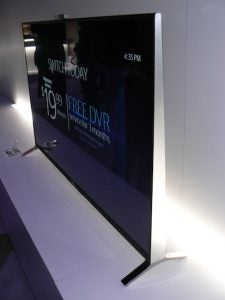 What is it? To say that Sony’s new TVs stand out from the crowd would be an understatement. For starters many of the key models in its range – the W9 HD series, X900 4K series and the X950 4K flagship – all feature glossy black bezels that stretch way beyond the edges of their screens to accommodate strikingly large, forward-firing speakers (more on these later). But these models also stick out much further round the back than the current trend.
What is it? To say that Sony’s new TVs stand out from the crowd would be an understatement. For starters many of the key models in its range – the W9 HD series, X900 4K series and the X950 4K flagship – all feature glossy black bezels that stretch way beyond the edges of their screens to accommodate strikingly large, forward-firing speakers (more on these later). But these models also stick out much further round the back than the current trend.
In the X950’s case this is because the sets sport a direct LED system, where the lights sit directly behind the screen. But in the W9 and X900’s case, the depth is there to give the speakers more room. And since the speakers are positioned in the bottom half of the screen, Sony has been able to develop a distinctive wedge shape design, where the set widens gradually from top to bottom.
To emphasise this bold sculpting, Sony has applied a gleaming metallic finish to the wedge’s side panels.
What we think: While we’re big fans of the sound quality delivered by 2013’s X9 4K TVs, we’ve been wondering lately if its huge physical dimensions may have hurt its sales a bit. So it’s something of a surprise to see the chunkiness if anything exaggerated by the wedge design.
That said, the Wedge sets are kind of beautiful if you’re willing to embrace their bulk, except for the way that when wall hung, the angled back creates an uncomfortable looking gap between the TV’s top half and your wall.
The wedge shape isn’t just there to look pretty, mind you. As well as making room for better speakers, the wedge also increases the TV’s stability, as it puts more weight in the TV’s bottom half than its top. Because of this Sony has been able to use legs on the set that you can slide in and out along the TV’s bottom edge to suit the demands of your furniture, which is a neat innovation we really like the sound of.
The bottom line is that while we worry the Wedge design might be divisive, we’re also excited about its potential impact on sound quality.
2. Picture quality focus – including Sony’s Triluminos picture processing
What is it? Sony is focussing on picture quality as a key selling point for its 2014 TVs. This might sound obvious, but many of the other brands at CES seemed to be using design or ‘smart’ features as their main marketing attractions.
Heading up the picture attractions is Triluminos – Sony’s name for the quantum dot technology it introduced to such great effect last year for delivering a noticeably richer, more nuanced colour performance. Triluminos is found on all of Sony’s 4K TVs (more on these in a moment) as well as the W9 HD series.
There’s a new focus on brightness for Sony’s latest high-end models too. A feature brilliantly dubbed ‘X-tended Dynamic Range’ uses a newly developed algorithm in conjunction with local dimming technology to handle light distribution in pictures more efficiently, so that bright parts can look significantly brighter without dark parts losing their black level depth.
And of course, there’s still Sony’s impressive X-Reality Pro processing system, complete with its outstanding upscaling of standard def to HD and, with the 4K sets, HD to 4K.
What we think? Until we’re persuaded otherwise, we’re currently of the opinion that we’d much rather a brand focussed on picture quality than curved screens. And from what we saw on the CES show floor – with the usual show floor rider that we were contending with far from ideal viewing conditions – Sony’s focus on picture quality could be a real winner.
All the sets on show – which admittedly only included fairly high-end models – delivered very impressive-looking picture results. The highlight, though, aptly enough, was the 85-inch 85X950. This is Sony’s flagship TV for 2014, combining its huge screen with a direct LED lighting system that delivers the maximum impact from the new X-Tended Dynamic Range feature.
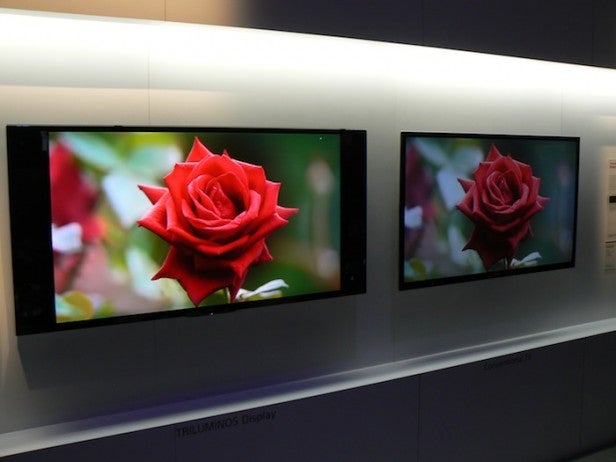
3. If picture quality is king, sound quality is queen
What is it? With picture quality improving more or less across the industry, Sony seems to have decided that one relatively easy way to steal a march over its rivals is with audio.
To accomplish superior sonics Sony has gone so far as to bravely add many inches to many of its TV’s sizes by sticking huge, front-firing speakers either side of their screens; to use the Wedge design to give the speakers more depth; and to integrate high-performance magnetic fluid design speakers into some of the higher-end TVs. Magnetic fluid technology allows slender, narrow speakers to produce a bigger sound.
What we think? Based on the superb audio performance of 2013’s X9005A 4K TVs, we’re very happy to find a similar level of speaker prowess inside a wider range of Sony models for 2014. The only potential downside is the extra inches the speakers add to Sony’s TV front and profile dimensions, as we could imagine this dividing tastes.
4. Improved control via One-Flick
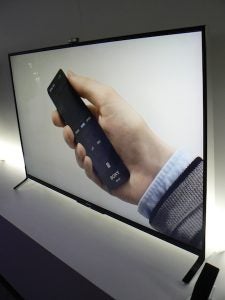 What is it? Sony’s entry into the list of smart TV control innovations at CES is dubbed One-Flick – and as its name suggests it lets you ‘surf’ recorded and online content simply by flicking the remote up and down.
What is it? Sony’s entry into the list of smart TV control innovations at CES is dubbed One-Flick – and as its name suggests it lets you ‘surf’ recorded and online content simply by flicking the remote up and down.
What we think: The One-Flick approach seems a bit alien at first, but we would suspect that it won’t take too long before you start getting the hang of it. At which point it will doubtless prove a considerable improvement on the usual track pad control approaches.
One-Flick doesn’t currently appear to be as flexible as LG’s new Magic Remote and WebOS Smart interface, but it’s still a big improvement – especially as it’s working with an improved smart TV service. More on this later.
5. There’s no curved screens and no OLED
What is it? Unlike its Korean rivals, Sony was showing zero serious interest in either OLED technology or curved screens at the CES – despite having shown off both technologies in previous trade shows.
What we think: We’ve yet to find ourselves yearning for curves and we have a feeling we’re not alone. So while not ‘doing the curve’ might have denied Sony a few easy headlines from the CES it could serve the brand well if curves turn out to be a failure or flash in the pan – especially if staying flat gives Sony any sort of price advantage.
The lack of any OLED showing is more disappointing, especially given that Sony’s 4K OLED was our favourite display of last year’s CES. However, with all the suggestions being that OLED is still far too hard to mass produce to be in any way affordable Sony’s decision to sideline it for now and put all of its efforts into single-mindedly pushing 4K LED doesn’t necessarily seem a bad one. Especially as most of the other big brands at the CES also seemed to be taking a step back from OLED.
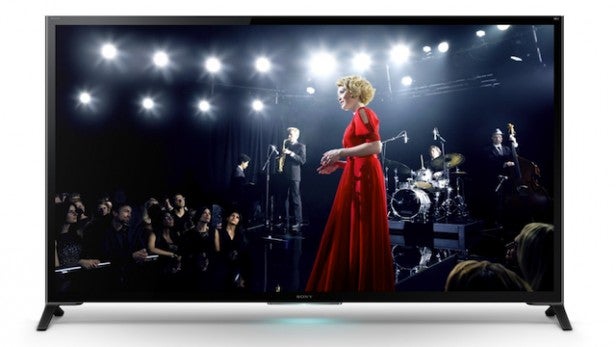
Sony Smart TV 2014: First Impressions
Sony has thankfully improved its Smart interface for 2014, introducing a more structured front end that simplifies – and glamourises – content finding without feeling obtrusive. After a little practice the new motion-based One-Flick remote control design should start to feel like a reasonably intuitive way of getting around the new menus too.
Probably Sony’s most promising Smart advances for 2014, though, involve content. For as well as being fully ready for Netflix’s 4K service when that launches, Sony’s CES booth was also showing a 4K version of Sony’s own Video Unlimited library, a 4K version of the ESPN on-demand platform, a new 500px app giving users access to a huge library of ultra HD photography, and Sony’s own PlayMemories app which lets you play your own UHD photos into the TV through a PS3 or 4 into a 4K TV.
All in all we’d say Sony should have one of the best content eco systems in the 2014 Smart landscape, but could feel just a little ‘traditional’ with its interface despite the addition of the One-Flick system.
Sony TVs in 2014: Key Models
Sony X900B series (estimated price: from £2,300-£7000)
- Available in 55, 65 and 79 inches
- Native UHD resolution, X-Tended Dynamic Range, Triluminos
- Multiple 4K streaming sources
This edge LED 4K series is one step down from the direct LED flagships, but we suspect it could be the most important 4K series in Sony’s range due to its mainstream balance of cost and high-end features. It will be interesting to see how the Wedge design goes down with the public too.
Sony X800B series (estimated price: from £1000-£1400)
- Available in 50 and 55 inches
- HD Resolution, Thin design, X-Reality Pro picture processing
- 3D with two pairs of glasses included
This is not the most glamorous set from Sony’s full HD LED range, but with its slim bezel and likely quite aggressive mid-range pricing it has the potential to be the most popular. Let’s just hope its picture quality is better than that of its equivalent model from 2013.
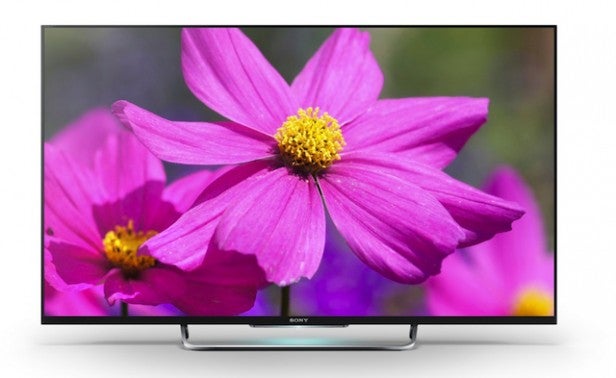
Sony TVs in 2014: Our first impressions
Sony is looking in much better shape to capitalise on its ‘end to end’ 4K story this year than it did last, thanks simply to having more 4K TV model sizes and price points for people to pick from. We’re really pleased, too, to see Sony persevering with its policy of getting back to putting quality – build quality, sound quality and picture quality – at the forefront of its TV thinking.
The amount of 4K streaming sources on show at Sony’s stand also bodes well for the brand’s ability to offer a genuine 4K content solution earlier than its rivals, and its new online system generally is better looking and more helpful than last year’s.
Pricing will be key, along with how much punters embrace the overtly stylised design of its premium models. But hopefully for the sake of the TV industry as well as consumers 2014 will turn out to be the year where Sony really delivers on the TV promise it started to show a couple of years ago.
Next, read our guide to What is 4K TV and Ultra HD?

